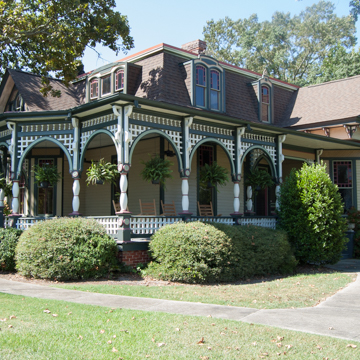You are here
Gunn-Bellenger House
Beginning around 1880, the long-isolated mineral region of mountainous northeastern Alabama came into its own economically. Gadsden, along with neighboring Attalla plus nearby Anniston and Fort Payne, were among the towns that blossomed during this period. Its Gunn-Bellenger House is an exceptionally intact example of the more ambitious domestic architecture that flourished in these communities, and indeed throughout Alabama, as the pace of development gained momentum in the last two decades of the nineteenth century. The house also suggests the increasing homogenization of style apparent across America at the time, as an expanding rail network and a proliferation of books and periodicals knit the country closer together.
Gadsden itself had been born as a “paper town” in 1845, platted by a handful of local speculators who anticipated the arrival of the proposed Coosa and Tennessee Railroad at what was then a straggling settlement where the Huntsville stagecoach road brushed the banks of the Coosa River. The new town was named for James Gadsden, then president of the South Carolina Railroad and destined to be the ambassador whose eponymous treaty with Mexico in 1853 added some 30,000 square miles to the southwestern United States. The railroad line did not materialize, however, and the fledgling community drowsed on beneath the wooded brow of Lookout Mountain until after the Civil War, becoming a trading center for surrounding farmers and a landing on the steamboat route between Rome, Georgia, and the head of the Coosa rapids at Greensport. In 1867 Gadsden became the seat of newly minted Baine County, soon to become Etowah. And when the railroad eventually did arrive in 1875, the town stirred to life and prospered as nascent industry and manufacturing tapped into local deposits of coal, iron, and timber.
In April 1886, Edward Tracy Hollingsworth purchased a lot at what was then the southwestern edge of town and began construction of the residence now known as the Gunn-Bellenger House. Son of a prominent local merchant and recently graduated from Alabama Polytechnic Institute (today’s Auburn University), Hollingsworth was newly married to Julia Parrott of Cartersville, Georgia. In November the young couple moved into their new residence. Employing the freewheeling terminology of the 1880s, contemporaries would have likely described it as a “Queen Anne cottage.” In actuality, it is a typical eclectic confection of the period: boldly asymmetrical, partly enfolded by a latticed Eastlake porch visually somewhat at odds with a steep-sided mansard roof borrowed from the Second Empire style. At either end of the porch, hooded gables, bracketed beneath, thrust from the main roofline over bay-windowed pavilions.
Inside, the late-nineteenth-century architectural character of the house remains essentially undisturbed, though decorative trim is unexpectedly spare in the high-ceilinged rooms. The southern predisposition for a bisecting through-hall is maintained, terminating in this instance with a narrow, reverse-flight stair framed by a wooden archway.
Regional custom also asserted itself in the construction of a detached kitchen some thirty feet behind the main residence (when fire claimed the kitchen in the early 1900s, its successor was installed in the main house). Completing the 1880s ensemble of outbuildings was a servants’ quarters and stable, now razed.
In 1901, the Hollingsworths moved to Oklahoma. Dr. Charles Logan Gunn and his New Orleans–born wife, Florence, then purchased the house. For the next ninety years it remained in the same family, passing to their daughter, Carolyn Gunn Bellenger. Meanwhile the surrounding town, after reaching a peak population of 58,000 in 1960, began a slow post-industrial decline. After Carolyn’s death in 1990, her landmark residence was bequeathed to the City of Gadsden for public use and enjoyment, one of the few notable residences surviving from Gadsden’s early boom years.
Listed on the National Register in 1993, the Gunn-Bellenger House was partially restored in the mid-1990s. Ironically, it was at this time that the house lost the delicate metal cresting that had fringed the mansard roof. “Temporarily” removed during roof repair work, the cresting has never been put back. Today the Gunn-Bellenger House is managed as a municipal facility by the Mary G. Hardin Center for Cultural Arts. It is open by appointment and rented as a venue for special events.
References
Martin, Will I. (Frances Underwood, compiler). If Memory Serves. Cleveland, TN: Banner Print, 1951.
Nelson, Cyndi. “Gunn-Bellenger House has special place in local, state history.” The Gadsden Times(Alabama), March 20, 2014.
Woman’s Club of Gadsden. A Little Book About Gadsden. Gadsden, AL: Howe Printing Co., 1938.
Writing Credits
If SAH Archipedia has been useful to you, please consider supporting it.
SAH Archipedia tells the story of the United States through its buildings, landscapes, and cities. This freely available resource empowers the public with authoritative knowledge that deepens their understanding and appreciation of the built environment. But the Society of Architectural Historians, which created SAH Archipedia with University of Virginia Press, needs your support to maintain the high-caliber research, writing, photography, cartography, editing, design, and programming that make SAH Archipedia a trusted online resource available to all who value the history of place, heritage tourism, and learning.














